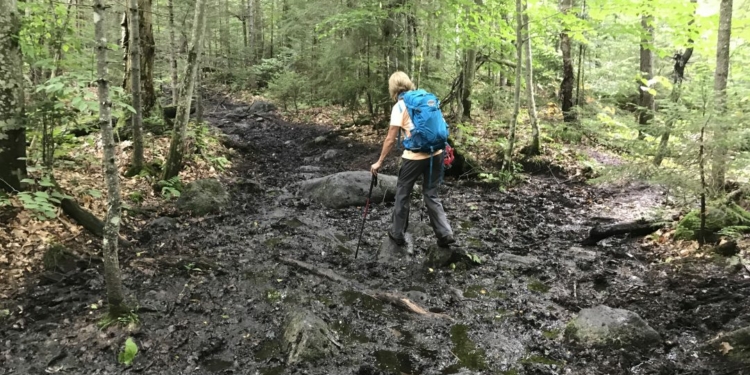Anyone who has hiked the Adirondacks Mountains knows they are known for a few things: miles and miles of fantastic trails, spectacular views, thousands of picturesque lakes and streams and waterfall and … mud.
Spring brings the annual mud season to the ADKs, and with it comes the annual state Department of Environmental Conservation mud advisory asking all hikers to hold off hiking above 2,500 feet until the trails have had a chance to dry out and harden up a bit.
While there are parts of the 6.1 million-acre park where mud season runs from before the snow melts to after it falls again, this time of year it is particularly bad in all areas. Hikers can do the most damage when the trails are wet, and particularly if they succumb temptations and walk off trail into the woods to avoid the really muddy spots.
Really muddy, by Adirondack standards is relative to none other, and there are some spots where you can go mid-calf in muck if you happen to slip off a log or a rock.

“Hikers are advised to avoid high elevation trails for the duration of the muddy trail advisory for several reasons: sliding boots destroy trail tread, damage surrounding vegetation, and erode thin soils to cause washouts; rotten snow and monorails are a safety hazard even with proper equipment; and high elevation and alpine vegetation are extremely fragile in spring months while starting regrowth after the winter,” according to the DEC.
There are many spots above 2,500 feet that are still covered in snow and ice. These steep trails feature thin soils that become a mix of ice and mud as winter conditions melt and frost leaves the ground. The remaining compacted ice and snow on trails is rotten, slippery, and will not reliably support weight. “Monorails,” narrow strips of ice and compacted snow at the center of trails, are difficult to hike and the adjacent rotten snow is particularly prone to postholing.
The DEC is asking hikers to avoid the following:
• High Peaks Wilderness — all trails above 2,500 feet specifically Algonquin, Colden, Feldspar, Gothics, Indian Pass, Lake Arnold cross-over, Marcy, Marcy Dam, Avalanche Lake, Colden, the Phelps Trail above Johns Brook Lodge, the Great Range Trail, Skylight, Wright, all “trail-less” peaks, and all trails above Elk Lake and Round Pond in the former Dix Mountain Area.
• Giant Mountain Wilderness — all trails above Giant’s Washbowl, “the Cobbles,” and Owl Head Lookout;
• McKenzie Mountain Wilderness — all trails above 2,500 feet, specifically Whiteface, Esther, Moose and McKenzie Mountains;
• Sentinel Range Wilderness – all trails above 2,500 feet, specifically Pitchoff Mountain
• Jay Mountain Wilderness – specifically Jay Mountain.

Until conditions improve, hikers are encouraged to explore low elevation trails or enjoy other forms of recreation.
Mud and variable conditions are prevalent across all trails in the Adirondacks. Hikers can encounter thick mud, flooding, ice, and deep slushy snow even on low-elevation trails. Hikers should be prepared to encounter thick mud, flooding, ice and deep slushy snow and know how to reduce their impact to protect surrounding natural resources.
Hikers are advised to walk through the mud, slush, or water, and down the center of the trail to help reduce erosion and trail widening and minimize damage to trailside vegetation. Waterproof boots, gaiters, and trekking poles are recommended to safely, and comfortably, traverse these variable trail conditions.
The muddy trail advisory for high elevation trails can last into June but may be lifted as soon as May for lower elevation trails.
For weekly updates on trail conditions, seasonal road closures and general recreation information in the Adirondacks, hikers are advised to check the Adirondack Backcountry Information webpages on the DEC website.



